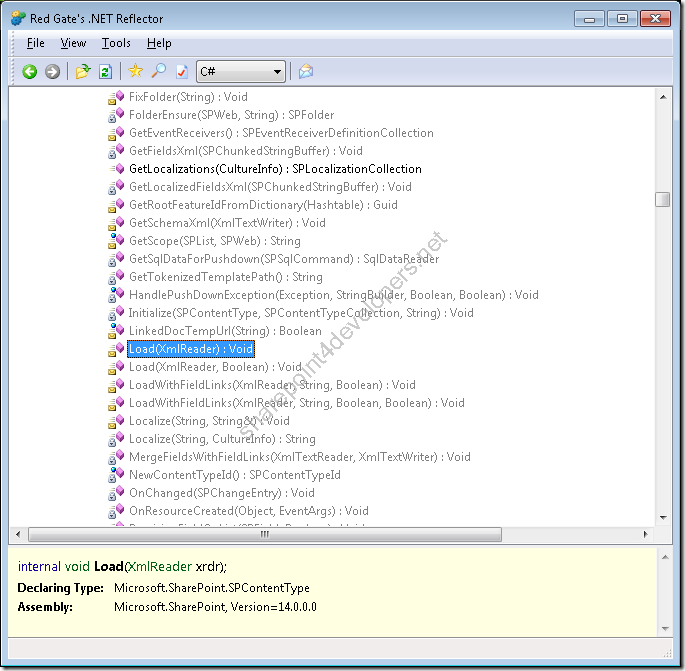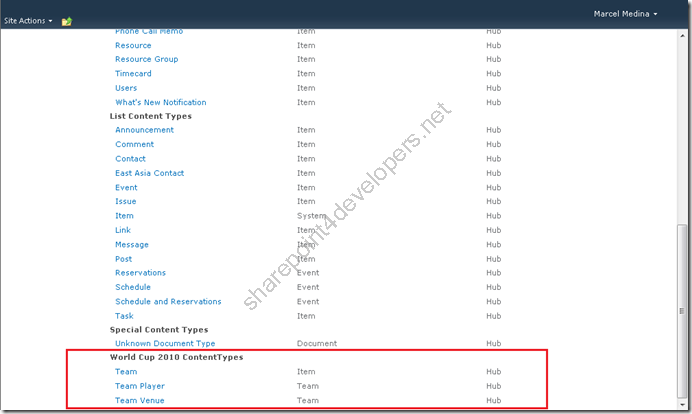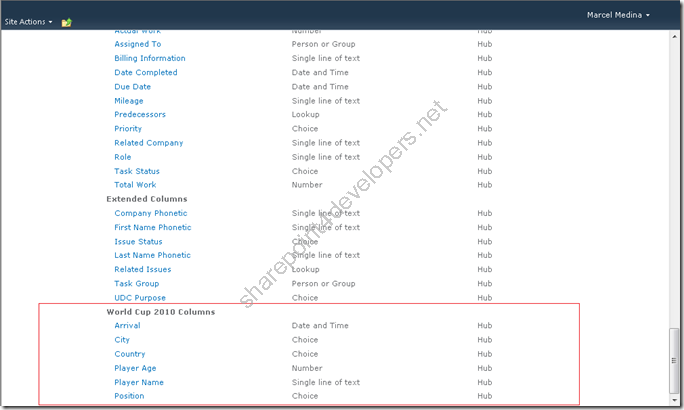Hi folks,
Here we go with one more quick note, the approach now is creating content types programmatically via XML. This approach is not usual, because it requires Reflection to use some Internal methods of the SPContentType class (Microsoft.SharePoint namespace).
It is possible to create Content Types using XML in case a Feature is created for that, however if you have a XML and don’t want to create a Feature, the only way is using Reflection as solution.
Consider the following XML:
Code Snippet
- <Elements xmlns="http://schemas.microsoft.com/sharepoint/">
- <ContentType ID="0x0100BEBD79039D12B646B28237616422B927"
- Name="Team"
- Group="World Cup 2010 ContentTypes"
- Version="1">
- <Folder TargetName="_cts/Team" />
- <XmlDocuments>
- <XmlDocument NamespaceURI="http://schemas.microsoft.com/sharepoint/v3/contenttype/forms">
- <FormTemplates xmlns="http://schemas.microsoft.com/sharepoint/v3/contenttype/forms">
- <Display>ListForm</Display>
- <Edit>ListForm</Edit>
- <New>ListForm</New>
- </FormTemplates>
- </XmlDocument>
- </XmlDocuments>
- <FieldRefs>
- <FieldRef ID="{fa564e0f-0c70-4ab9-b863-0177e6ddd247}" Name="Title" Required="TRUE" />
- <FieldRef ID="{05a571ad-f9d1-4aab-a703-1af3ae393fbf}" Name="Country" Required="TRUE" />
- </FieldRefs>
- </ContentType>
- <ContentType ID="0x0100BEBD79039D12B646B28237616422B92701"
- Name="Team Player"
- Group="World Cup 2010 ContentTypes"
- Version="1">
- <Folder TargetName="_cts/Team Player" />
- <XmlDocuments>
- <XmlDocument NamespaceURI="http://schemas.microsoft.com/sharepoint/v3/contenttype/forms">
- <FormTemplates xmlns="http://schemas.microsoft.com/sharepoint/v3/contenttype/forms">
- <Display>ListForm</Display>
- <Edit>ListForm</Edit>
- <New>ListForm</New>
- </FormTemplates>
- </XmlDocument>
- </XmlDocuments>
- <FieldRefs>
- <FieldRef ID="{fa564e0f-0c70-4ab9-b863-0177e6ddd247}" Name="Title" Required="TRUE" />
- <FieldRef ID="{05a571ad-f9d1-4aab-a703-1af3ae393fbf}" Name="Country" Required="TRUE" />
- <FieldRef ID="{04555083-ec04-4c20-a609-42a283428374}" Name="PlayerName" Required="TRUE" />
- <FieldRef ID="{2f2abeb9-ed3d-41d9-bbde-03d1150396a1}" Name="PlayerAge" Required="FALSE" />
- <FieldRef ID="{ea4b814a-a18b-403a-a33a-8ea5436cb540}" Name="Position" Required="TRUE" />
- </FieldRefs>
- </ContentType>
- <ContentType ID="0x0100BEBD79039D12B646B28237616422B92702"
- Name="Team Venue"
- Group="World Cup 2010 ContentTypes"
- Version="1">
- <Folder TargetName="_cts/Team Venue" />
- <XmlDocuments>
- <XmlDocument NamespaceURI="http://schemas.microsoft.com/sharepoint/v3/contenttype/forms">
- <FormTemplates xmlns="http://schemas.microsoft.com/sharepoint/v3/contenttype/forms">
- <Display>ListForm</Display>
- <Edit>ListForm</Edit>
- <New>ListForm</New>
- </FormTemplates>
- </XmlDocument>
- </XmlDocuments>
- <FieldRefs>
- <FieldRef ID="{fa564e0f-0c70-4ab9-b863-0177e6ddd247}" Name="Title" Required="TRUE" />
- <FieldRef ID="{05a571ad-f9d1-4aab-a703-1af3ae393fbf}" Name="Country" Required="TRUE" />
- <FieldRef ID="{af008077-3a7e-41d9-aaca-2b0997bb5e25}" Name="HostCity" Required="TRUE" />
- <FieldRef ID="{9910fa0d-c7e8-464a-9607-caba1502b7dc}" Name="Arrival" Required="FALSE" />
- </FieldRefs>
- </ContentType>
- </ Elements >
In order to add the Content Types above, the code snippet below must be used:
Code Snippet
- using System;
- using System.Collections.Generic;
- using System.Linq;
- using System.Text;
- using System.Xml;
- using System.IO;
- using Microsoft.SharePoint;
- using CommonLibrary;
-
- namespace ContentTypes
- {
- class Program
- {
- static void Main(string[] args)
- {
- using (SPSite site = new SPSite("http://localhost"))
- {
- using (SPWeb web = site.RootWeb)
- {
- XmlDocument xmlDoc = new XmlDocument();
-
- xmlDoc.Load(Path.GetFullPath("ContentTypes.xml"));
-
- foreach (XmlElement fieldNode in xmlDoc.DocumentElement.ChildNodes)
- {
- SPContentType ct = ContentTypesHelper.CreateEmptyContentType();
-
- XmlTextReader xmlReader = new XmlTextReader(fieldNode.OuterXml, XmlNodeType.Element, new XmlParserContext(xmlDoc.NameTable, null, "en", XmlSpace.Default));
-
- ContentTypesHelper.LoadContentTypeFromXml(ct, xmlReader);
-
- ContentTypesHelper.SetContentTypeScope(ct, web);
-
- site.RootWeb.ContentTypes.Add(ct);
-
- site.RootWeb.Update();
- }
- }
- }
- }
- }
- }
When analising the code above, it is possible to note that the methods CreateEmptyContentType, LoadContentTypeFromXml and SetContentTypeScope are resposible for the Content Types creation, and are contained in the class ContentTypesHelper. These methods use Reflection and were created by Robert Fridén in his blog few years ago, now I am reusing them.
Through the .NET Reflector it is possible to identify Internal methods of the Microsoft.SharePoint.SPContentType class, according the Figure below:
 Figure 1 – SPContentType class visualised through the .NET Reflector
Figure 1 – SPContentType class visualised through the .NET Reflector
Check out the code of the ContentTypesHelper class:
Code Snippet
- using System;
- using System.Collections.Generic;
- using System.Linq;
- using System.Text;
- using System.Reflection;
- using System.Xml;
- using Microsoft.SharePoint;
-
- namespace CommonLibrary
- {
- public class ContentTypesHelper
- {
- /// <summary>
- /// Creates an Empty Content Type
- /// </summary>
- public static SPContentType CreateEmptyContentType()
- {
- ConstructorInfo constructor = (typeof(SPContentType)).GetConstructor(
- BindingFlags.NonPublic | BindingFlags.Instance,
- null,
- Type.EmptyTypes,
- null);
-
- SPContentType ctype = (SPContentType)constructor.Invoke(new object[0]);
-
- return ctype;
- }
-
- /// <summary>
- /// Loads Content Type from XML
- /// </summary>
- public static void LoadContentTypeFromXml(SPContentType ctype, XmlTextReader xmlReader)
- {
- MethodInfo loadMethod = ctype.GetType().GetMethod("Load",
- BindingFlags.NonPublic | BindingFlags.Instance,
- null,
- new Type[] { typeof(XmlReader) },
- null);
-
- loadMethod.Invoke(ctype, new object[] { xmlReader });
- }
-
- /// <summary>
- /// Sets Content Type from XML
- /// </summary>
- public static void SetContentTypeScope(SPContentType ctype, SPWeb web)
- {
- string scope = web.ServerRelativeUrl.TrimStart('/');
-
- MethodInfo setCTScopeMethod = ctype.GetType().GetMethod(
- "SetScope",
- BindingFlags.NonPublic | BindingFlags.Instance,
- null,
- new Type[] { typeof(string) },
- null);
-
- setCTScopeMethod.Invoke(ctype, new object[] { scope });
-
- PropertyInfo fieldLinksScopeProperty = ctype.FieldLinks.GetType().GetProperty(
- "Scope",
- BindingFlags.NonPublic | BindingFlags.Instance,
- null,
- typeof(string),
- Type.EmptyTypes,
- null);
-
- fieldLinksScopeProperty.SetValue(ctype.FieldLinks, scope, new object[0]);
-
- PropertyInfo contentTypeWebProperty = ctype.GetType().GetProperty(
- "Web",
- BindingFlags.NonPublic | BindingFlags.Instance,
- null,
- typeof(SPWeb),
- Type.EmptyTypes,
- null);
-
- contentTypeWebProperty.SetValue(ctype, web, new object[0]);
- }
- }
- }
In the end the Content Types will be created according the Figure below:
 Figure 2 – Content Types Creation
Figure 2 – Content Types Creation
Download the solution here.
Considerations
-
The Site Columns are not inherited automatically in this approach. Note that the Content Types of the XML are listing all the columns, which wouldn’t be necessary if the inheritance was working properly.
-
The addition of the property Inherits=TRUE does not change this behaviour.
References:
http://msdn.microsoft.com/en-us/library/system.reflection.bindingflags.aspx
http://www.15seconds.com/issue/050602.htm
http://vspug.com/bobsbonanza/2007/12/17/deploying-site-columns-and-content-types-to-sharepoint-webs
http://www.red-gate.com/products/reflector
Cheers,
Marcel Medina


Click here to read the same content in Portuguese.
Hi folks,
From now on I will also post some quick notes of SharePoint development. I believe they are going to be very useful in our daily activities.
In this post I demonstrate how to create Site Columns programatically via XML.
Consider the following Site Columns XML:
Code Snippet
- <Elements xmlns="http://schemas.microsoft.com/sharepoint/">
- <Field Type="Choice" Description="List of countries" Required="TRUE" Format="Dropdown" FillInChoice="FALSE" Group="World Cup 2010 Columns" ID="{05A571AD-F9D1-4aab-A703-1AF3AE393FBF}" StaticName="Country" Name="Country" DisplayName="Country" Version="1">
- <CHOICES>
- <CHOICE>Algeria</CHOICE>
- <CHOICE>Argentina</CHOICE>
- <CHOICE>Australia</CHOICE>
- <CHOICE>Brazil</CHOICE>
- <CHOICE>Cameroon</CHOICE>
- <CHOICE>Chile</CHOICE>
- <CHOICE>Côte d'Ivoire</CHOICE>
- <CHOICE>Denmark</CHOICE>
- <CHOICE>England</CHOICE>
- <CHOICE>France</CHOICE>
- <CHOICE>Germany</CHOICE>
- <CHOICE>Ghana</CHOICE>
- <CHOICE>Greece</CHOICE>
- <CHOICE>Honduras</CHOICE>
- <CHOICE>Italy</CHOICE>
- <CHOICE>Japan</CHOICE>
- <CHOICE>Korea DPR</CHOICE>
- <CHOICE>Korea Republic</CHOICE>
- <CHOICE>Mexico</CHOICE>
- <CHOICE>Netherlands</CHOICE>
- <CHOICE>New Zealand</CHOICE>
- <CHOICE>Nigeria</CHOICE>
- <CHOICE>Paraguay</CHOICE>
- <CHOICE>Portugal</CHOICE>
- <CHOICE>Serbia</CHOICE>
- <CHOICE>Slovakia</CHOICE>
- <CHOICE>Slovenia</CHOICE>
- <CHOICE>South Africa</CHOICE>
- <CHOICE>Spain</CHOICE>
- <CHOICE>Switzerland</CHOICE>
- <CHOICE>Uruguay</CHOICE>
- <CHOICE>USA</CHOICE>
- </CHOICES>
- </Field>
- <Field Type="Choice" Description="List of host cities" Required="TRUE" Format="Dropdown" FillInChoice="FALSE" Group="World Cup 2010 Columns" ID="{AF008077-3A7E-41d9-AACA-2B0997BB5E25}" StaticName="HostCity" Name="HostCity" DisplayName="City" Version="1">
- <Default>Johannesburg</Default>
- <CHOICES>
- <CHOICE>Cape Town</CHOICE>
- <CHOICE>Durban</CHOICE>
- <CHOICE>Johannesburg</CHOICE>
- <CHOICE>Mangaung/Bloemfontein</CHOICE>
- <CHOICE>Nelson Mandela Bay/Port Elizabeth</CHOICE>
- <CHOICE>Nelspruit</CHOICE>
- <CHOICE>Polokwane</CHOICE>
- <CHOICE>Rustenburg</CHOICE>
- <CHOICE>Tshwane/Pretoria</CHOICE>
- </CHOICES>
- </Field>
- <Field Type="Choice" Description="List of players" Required="TRUE" Format="Dropdown" FillInChoice="FALSE" Group="World Cup 2010 Columns" ID="{EA4B814A-A18B-403a-A33A-8EA5436CB540}" StaticName="Position" Name="Position" DisplayName="Position" Version="1">
- <CHOICES>
- <CHOICE>Defensive Midfielder</CHOICE>
- <CHOICE>Forward</CHOICE>
- <CHOICE>Goalkeeper</CHOICE>
- <CHOICE>Left Back</CHOICE>
- <CHOICE>Left Midfielder</CHOICE>
- <CHOICE>Right Back</CHOICE>
- <CHOICE>Right Midfielder</CHOICE>
- <CHOICE>Stopper</CHOICE>
- <CHOICE>Striker</CHOICE>
- <CHOICE>Sweeper</CHOICE>
- </CHOICES>
- </Field>
- <Field Type="Text" Description="The name of the player" Required="TRUE" MaxLength="255" Group="World Cup 2010 Columns" ID="{04555083-EC04-4c20-A609-42A283428374}" StaticName="PlayerName" Name="PlayerName" DisplayName="Player Name"></Field>
- <Field Type="Number" Description="The age of the player" Required="FALSE" Decimals="0" Group="World Cup 2010 Columns" ID="{2F2ABEB9-ED3D-41d9-BBDE-03D1150396A1}" StaticName="PlayerAge" Name="PlayerAge" DisplayName="Player Age"></Field>
- <Field Type="DateTime" Description="The date of arrival" Required="FALSE" Format="DateOnly" Group="World Cup 2010 Columns" ID="{9910FA0D-C7E8-464a-9607-CABA1502B7DC}" StaticName="Arrival" Name="Arrival" DisplayName="Arrival" />
- </Elements>
In order to add the Site Columns above, the code snippet below must be used:
Code Snippet
- using System;
- using System.Collections.Generic;
- using System.Linq;
- using System.Text;
- using System.Xml;
- using System.IO;
- using Microsoft.SharePoint;
-
- namespace SiteColumns
- {
- public class Program
- {
- public static void Main(string[] args)
- {
- using (SPSite site = new SPSite("http://localhost/"))
- {
- XmlDocument xmlDoc = new XmlDocument();
-
- xmlDoc.Load(Path.GetFullPath("SiteColumns.xml"));
-
- foreach (XmlElement fieldNode in xmlDoc.DocumentElement.ChildNodes)
- {
- site.RootWeb.Fields.AddFieldAsXml(fieldNode.OuterXml);
- }
- }
- }
- }
- }
In the end the Site Columns will be created according the Figure below:

Figure 1 – Creating Site Columns
Download the solution here.
Cheers
Marcel Medina


Click here to read the same content in Portuguese.
Hi folks,
The integration Visual Studio 2010 x SharePoint Foundation 2010 when deploying BDC Model Solutions still presents some issues. The problem occurs in Visual Studio because it cannot find the required DLLs to perform the operation. The error messages are listed below:
Problems:
Error occurred in deployment step 'Add Solution': Failed to load receiver assembly "Microsoft.Office.SharePoint.ClientExtensions, Version=14.0.0.0, Culture=neutral, PublicKeyToken=71e9bce111e9429c" for feature "<Sua Feature>: System.IO.FileNotFoundException: Could not load file or assembly 'Microsoft.Office.SharePoint.ClientExtensions, Version=14.0.0.0, Culture=neutral, PublicKeyToken=71e9bce111e9429c' or one of its dependencies. The system cannot find the file specified.
File name: 'Microsoft.Office.SharePoint.ClientExtensions, Version=14.0.0.0, Culture=neutral, PublicKeyToken=71e9bce111e9429c'
at System.Reflection.Assembly._nLoad(AssemblyName fileName, String codeBase, Evidence assemblySecurity, Assembly locationHint, StackCrawlMark& stackMark, Boolean throwOnFileNotFound, Boolean forIntrospection)
at System.Reflection.Assembly.InternalLoad(AssemblyName assemblyRef, Evidence assemblySecurity, StackCrawlMark& stackMark, Boolean forIntrospection)
at System.Reflection.Assembly.InternalLoad(String assemblyString, Evidence assemblySecurity, StackCrawlMark& stackMark, Boolean forIntrospection)
at System.Reflection.Assembly.Load(String assemblyString)
at Microsoft.SharePoint.Administration.SPFeatureDefinition.get_ReceiverObject()
Error occurred in deployment step 'Add Solution': Could not load file or assembly 'Microsoft.Office.Server, Version=14.0.0.0, Culture=neutral, PublicKeyToken=71e9bce111e9429c' or one of its dependencies. The system cannot find the file specified.
Solution:
In order to cross off this problem, some files of SharePoint Server 2010 need to be copied, which can be found in the directory 14\ISAPI:
- microsoft.office.sharepoint.clientextensions.dll
- Microsoft.Office.Sharepoint.ClientExtensions.xml
- Microsoft.Office.Server.dll
- Microsoft.Office.Server.xml
Register the DLLs in the GAC to fix it, just copying them to the directory C:\Windows\assembly.
Reopen the Visual Studio 2010 and deploy your BDC Model Solution successfully!
Cheers,
Marcel Medina


Click here to read the same content in Portuguese.